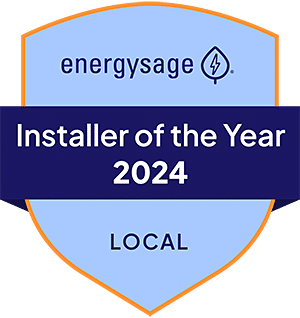The cost of a solar energy system varies from home to home. It depends on many factors, and the most influential are:
For estimating, here is one example — An average system in our geographic location is designed with approximately 30 panels. Such a system will generate around 14,000 kWh/year and will cost between $32,000 and $38,000 before the 30% federal tax credit is applied, or between $22,400-$26,600 after the tax credit. Please visit a recent blog article from 2022 for a more detailed explanation of solar electric costs.
The payback, or return on investment, for solar is very situationally dependent. The factors that influence solar payback the most are the effectiveness of the installed system (how ideally are the panels situated, how shaded is the roof that the panels are installed on, etc.) and the economic savings factors (how much are you paying for electricity that solar will help you avoid, and how much are the SRECs worth in your state?). Getting an accurate forecasting of solar payback is one of the core responsibilities of Exact Solar’s sales engineers when they work with homeowners to prepare a custom-designed system. They will cover the following key variables as part of our solar consultations:
Please visit our calculating solar savings page to learn in more detail and through examples.
There are two primary incentives in Pennsylvania and New Jersey — The Investment Tax Credit (ITC) and SRECs.
The 30 percent federal ITC has been renewed through 2032, a result of the Inflation Reduction Act. By filing an additional form with your federal taxes the year following completion of the installation, you will receive a tax credit equal to 30% of the total cost of your solar energy system. For example, if you’re system is completed in 2022, you will file for your return in 2023.
SRECs stand for solar renewable energy credits and both Pennsylvania and New Jersey have active SREC programs that have been around for years. SRECs are like grants that pay out over time. You earn 1 SREC for every 1,000 kWh your solar energy system generates, so a system generating 14,000 kWh in a year would produce 14 SRECs annually. SREC payments are considered a second revenue stream when you go solar. The first is the actual utility savings (you don’t have to buy as much, or any, power from the grid anymore) and the second is the SREC revenue that you receive. SRECs are your extra bonus for going solar!
For commercial projects, there are additional incentives available including an accelerated depreciation benefit for those that have a tax basis. PECO and PPL (and many other utilities) also have a small one-time up-front rebate for installing solar. As of 2023, PECO pays $.10/kWh generated in year 1 as a small rebate. PPL pays $.03/kWH. Again, these are only for commercial projects.
SRECs, an acronym that stands for “solar renewable energy credits”, are a financial device allowing utilities and electricity suppliers to buy “credit” for renewable and solar energy in lieu of investing in and generating the same power. There is a process to apply for and be granted these credits that are issued over 10 years or longer, depending on your state. Exact Solar assists every customer as needed.
Repeating part of the prior FAQ on “what rebates and incentives are available”, SRECs are like grants that pay out over time. You earn 1 SREC for every 1,000 kWh your solar energy system generates, so a system generating 14,000 kWh in a year would produce 14 SRECs annually. SREC payments are considered a second revenue stream when you go solar. The first is the actual utility savings (you don’t have to buy as much, or any, power from the grid anymore) and the second is the SREC revenue that you receive. SRECs are your extra bonus for going solar!
The value of each SREC varies from New Jersey to Pennsylvania. Both states have active SREC programs that have been around for years. While more valuable in New Jersey currently, the credit value in Pennsylvania is increasing and there are active efforts underway in Harrisburg legislatively to try and further support the state’s SREC program long-term. Please visit our SRECs page for more information about the certificates and the results in each state.
Net metering is the most important policy allowing a homeowner compensation for the power the solar energy system generates. Net metering allows you to get credit for energy produced by your solar array, whether you use it immediately in your home, or at a later date. After installing solar, the utility company swaps your “one way meter” for a smarter bidirectional solar meter. This enables them to track power flowing into the home and power flowing out of the home. When your home isn’t consuming all the power being generated by the solar array, that excess power flows out to the grid. When your home is consuming more power than the solar energy system is producing, the home pulls the additional power it needs from the grid. However, net metering means that you get full, 100% credit value for each kWh of electricity you send out to the grid to be used and offset against an equal kWh that you take from the grid at another time.
This policy is very important for solar because solar (unless you have a solar battery system as well) cannot store energy. It produces energy and if the home can’t use it at that time, it must flow out to the grid. Net metering essentially allows the grid to function like a giant virtual battery and is instrumental in ensuring you get full savings credit for all the solar energy your new solar PV system produces.
![]()
Please visit our calculating solar savings page to learn more about the net metering specifics for your state and how they lead to your savings.
Exact Solar does not recommend leasing solar energy systems. Power purchase agreements are the most common way solar energy systems are leased, and they tend to have a negative perception in the market due to customer feedback. Exact Solar feels that purchasing a solar energy system outright (either with cash or with a solar loan or home equity loan) is in the best financial interest of most people. It cuts out the middle man and simplifies the arrangement. It offers the most control and best payback to our customers, therefore it is what we universally recommend.
Solar panels are most effective in direct sunlight. However, if sunlight is reflected or partially blocked by clouds, the efficiency of the solar panels will decrease, but electricity will continue to be generated. Rain keeps panels running efficiently by cleaning off dirt and debris—so a rainy day once in a while isn’t all bad.
Solar PV systems have no moving parts, but the solar panels do degrade a small fractional percent annually over their lifetime and the systems do involve electronic components that can fall. All of the major equipment in a solar energy system is typically warranted for 25 years, especially the electronic components that can fail. Solar panel manufacturers also always include production guarantees that guarantee that the production from the solar panel will degrade no more than typically 0.5% annually. Systems can continue to produce clean energy for 40+ years if well-maintained and the industry often uses 30 years as the typically expected useful life. It’s important to remember though that there is nothing that will make a solar panel automatically stop working on the first day of the 31st year. Instead the system will just continue to degrade a small amount each year and as long as the system’s integrity remains in tact and the electronic components are in working order, it will continue to produce energy.
Solar panels and and the small electronic devices that monitor/control each solar panel (hidden underneath each panel, called optimizers or microinverters) are covered under a manufacturer’s warranty for 25 years. The central power inverters that convert the power from DC to AC energy are covered for 12 years by default, but Exact Solar always includes the added cost to extend this warranty to 25 years for our customers. Panels are guaranteed to produce at least 80-84% of their original production for 25 years, with some manufactures offering even higher long-term guarantees.
In addition to the manufacturer warranties, Exact Solar always offers our 10-year workmanship guarantee to stand behind the integrity of our installation work and the correct application of the products we install. We’re an 18+ year old company and we’ve been standing behind the quality of our work since our founding in 2005. Customer satisfaction is our priority, and we are committed to providing the long-term support our customers need after they get a solar energy system from us.
In Pennsylvania and New Jersey we get a great benefit from the periodic rains as well as the snowfalls, as they melt. They act as “cleaners” and for the most part are good enough to keep contaminants from collecting on the surfaces of solar panels. And by selecting only panels and power management hardware that have great service records, there is little need for inspections or other upkeep.
Yes. Except in the extremely rare circumstance where you decide to buy solar plus energy storage and become 100% “off-grid”, meaning you completely and permanently disconnect your home from the power grid. For most customers, even if you meet 100% of your annual electricity needs with solar and you have net metering, you still will get a bill for the minimum “customer charge” fee.
For the majority of solar homeowners however, they may meet 50%, or 70%, or 90% of their power needs from their solar energy system, but need to still purchase some smaller amount of power from the utility grid. When you work on a solar consultation with Exact Solar’s sales engineers, they will evaluate your utility usage and see what solar can be feasibly installed on your roof or in a ground-mount location, and they will run calculations to estimate how much of your current electricity bill can be offset. Our team is always conservative in our calculations and always strives to meet 100% of the existing utility needs for our customers, but it’s not always possible. Permitting codes require some roof areas to be left open for emergency personnel access and other “roof setback” requirements, so these factors, plus possible shading, can limit the maximum amount of solar that can be installed.
It’s also important to note that your home or business’s power usage isn’t necessarily a fixed, static number. The way you use power can and will change over time. You could get a more efficient HVAC or LED lighting to reduce your usage, or get an EV charger and electric vehicle to add usage. You also may simply change how often you are in your home (perhaps you’re working from home more these days?) and this can have an impact. All of these factors impact whether solar will meet 100% of your needs for power, or if you will still get a small bill from the utility.
Your savings are estimated based on our experience in the region. Weather changes throughout the seasons in ways that vary the amount of solar energy available. And nearly every family’s energy needs and usage fluctuate constantly. Because of that, we typically offer examples and a range of expected savings.
Learn more about calculating solar savings and the factors involved by visiting this page.
At Exact Solar, we take pride in our years of servicing Pennsylvania and New Jersey homeowners and businesses. We know the state codes and the local permitting authorities. We have learned the nuances of which municipalities have additional unique requirements, and which are easy to work with in a streamlined fashion. We know the local utilities and how to navigate their systems and process as optimally as possible.
While we don’t guarantee timelines, we do often see solar installed for most basic solar energy systems in 2-4 months after signing a contract to work with us. Some townships however have extra stringent permitting processes, so that can occasionally push a project’s timeline closer to 5 months, but it’s rare to go longer than that unless it’s a commercial project or a farm project where additional approvals may be needed from the Department of Agriculture.
Exact Solar self-performs all its work with our own full-time employees with the exception of some specialty trades that we occasionally bring in for support, such as specialized fencing, directional drilling for long trench runs, or installing footers for ground mount systems. We are extremely proud of our team and how much care they put into their work. We have regular safety meetings and ongoing training for everyone on our team. We truly prioritize safety, quality, and customer satisfaction and we hope it comes through in everything we do.
In our experience, most homeowners in the area are ready. Here is our test:
We think you are likely ready to investigate your solar savings potential. Many people are pleasantly surprised to discover how the process is not intimidating, and even more pleased to find out how quickly they can save while increasing the value of their home. See more about how solar improves home value.
The condition of your roof does not necessarily depend on its age. If debris from trees constantly falls on to your roof, it may be much more damaged than a roof that is free of debris. Typically, roofs that are not impacted by considerable falling debris are suitable for solar energy systems for up to 20 years. Exact Solar evaluates the condition of all roofs and makes any necessary recommendations.
Exact Solar uses flashings to cover penetrations in sloped roofs. The use of these flashings does not typically negate warranties on roofs. We can verify that your warranty will not be voided with the roof manufacturer.
Yes. In addition to a solar PV system, a battery backup system can be installed. Battery backup systems are used to power a home’s critical loads during a power outage. Critical loads may include sump pumps, wells, refrigerators, etc. Please take time to explore our solar plus storage product offering to learn more.



























Join Our Mailing List
Refer and Earn!
Click below for details on how to refer a friend or family member to earn $500!
Privacy Policy | Terms of Service | © 2025 Exact Solar, All Rights Reserved.
This site is protected by reCAPTCHA and the Google Privacy Policy and Terms of Service apply.